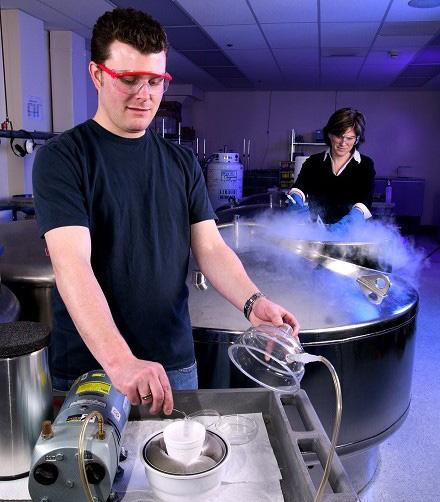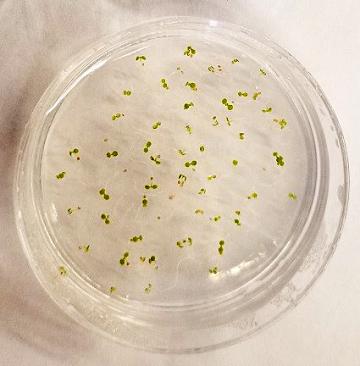The Germ of an Idea

ARS horticulturist Remi Bonnart, foreground, exposes plant tissues to liquid nitrogen to freeze them, while Christina Walters, background, holds a cryovat with seeds that have been stored in liquid nitrogen for about 30 years. The freezing and storage are part of NLGRP’s unique mission to cryopreserve plant germplasm. (Photo by Stephen Ausmus, D055-16).
What would life be like in a world with less water? You don’t have to ask a NASA scientist to find out; ARS is investigating that very question to prepare for future conditions right here on earth. As climate change reduces the availability of fresh water, researchers are trying to learn what mechanisms organisms already have to address water scarcity, and how to build on them to create a more resilient future.
Christina Walters, a plant physiologist at the ARS National Laboratory for Genetic Resources Preservation in Ft. Collins, CO, represents ARS on the WALII (Water and Life Interface Institute) project. Project team members describe it as an effort to study “how life interacts with water from the molecular to the organismal level, across plants, fungi, and animals, considering reduced water across the entire spectrum.” By working across traditional disciplinary boundaries and using new methods, the researchers believe that they will be able to pioneer a new field of “solid-state biology” to understand how living systems operate under conditions of desiccation. With decades of experience studying how plant seeds preserve their viability (reproductive ability) through stressors like drying and re-hydration, Walters was “a natural fit” for the group.
The project got its start when the original team found a molecule that they called “floe.” Expressed during the late stages of seed maturation, it allows seeds to dry out in an organized way, by structuring their cytoplasm so that it doesn’t crumble. The researchers soon discovered the same phenomena in yeast, tardigrades, and nematodes. The role that it plays is critical: according to Walters, plants’ ability to overwinter as seeds is one of the core traits that allowed humans to domesticate them, and thus to develop agriculture.
“A lot of the cereal grains that we use, like wheat and barley, developed around the Fertile Crescent, which is a pretty dry area,” she said. “The ability to survive that drying until you germinate – the element of waiting, and being able to disperse and then come up later, for survival, it works for the plants, it works for the people.”
Precisely how that process works is just one of the mysteries Walters will explore as the project brings her, in some sense, right up to the very boundary of life and death itself.

Immature Arabidopsis thaliana embryos serve as a model system for some of the WALII studies. In this experiment, researchers harvested seeds between 11 and 15 days after they flowered, a time when they become increasingly tolerant of drying (full maturity takes about 22 days). They dried seeds at exactingly-controlled relative humidities and then checked whether they survived by sowing them in a Petri plate on agar. At 75% relative humidity, most of the seeds, pictured here, survived and are growing normally. (Photo by Shaimaa Ibrahim, ARS)
“Usually we just ask, does a seed germinate or not,” she said. “We developed an assay where we could actually measure molecules fragmenting under dry conditions, and that was pretty compelling as a way to measure aging. Before, we compared desiccation-tolerant vs. not or alive vs. dead; the dichotomy is not really as interesting as how much damage cells have endured, and how much can be tolerated to allow recovery; that is, looking at the quantitative aspects – that’s never been done before.”
Walters believes that the results of the work will be fundamental to agricultural research.
“Everyone looks at biology in a fluid cell with things moving around, with lots of water, and this is biology that’s in a solid,” she said. “This is science that transcends just about everything that we do, even pharmaceuticals and food security.”
And it all comes down to seeds, and their ability to dry out, and then, almost magically, generate life anew again.
“A lot of people forget that seeds are alive, and that they do this amazing thing of drying down,” Walters said. “But that was what fascinated me about seeds at the very beginning: when you removed water, what types of metabolism the seed did, what some of the biophysics of the seed were – but it all centered on this amazing ability of seeds to live without water.” – Kathryn Markham, ARS Office of Communications.
You May Also Like:

